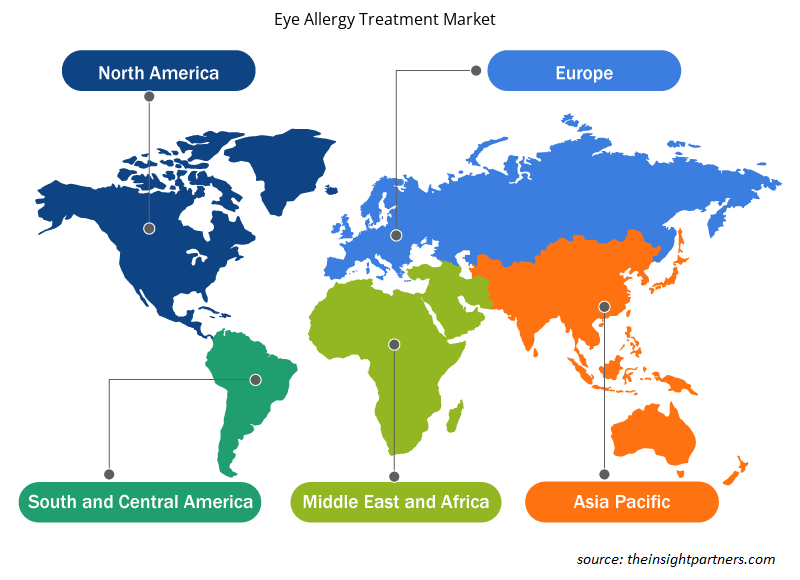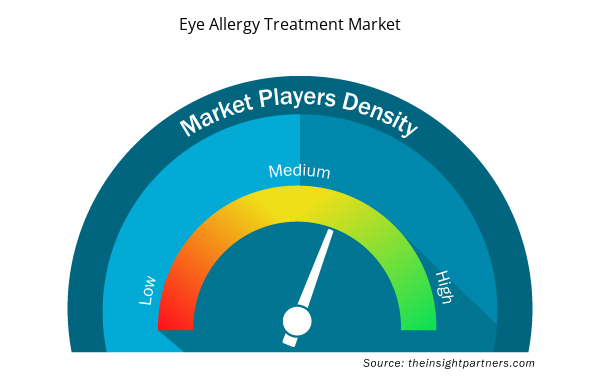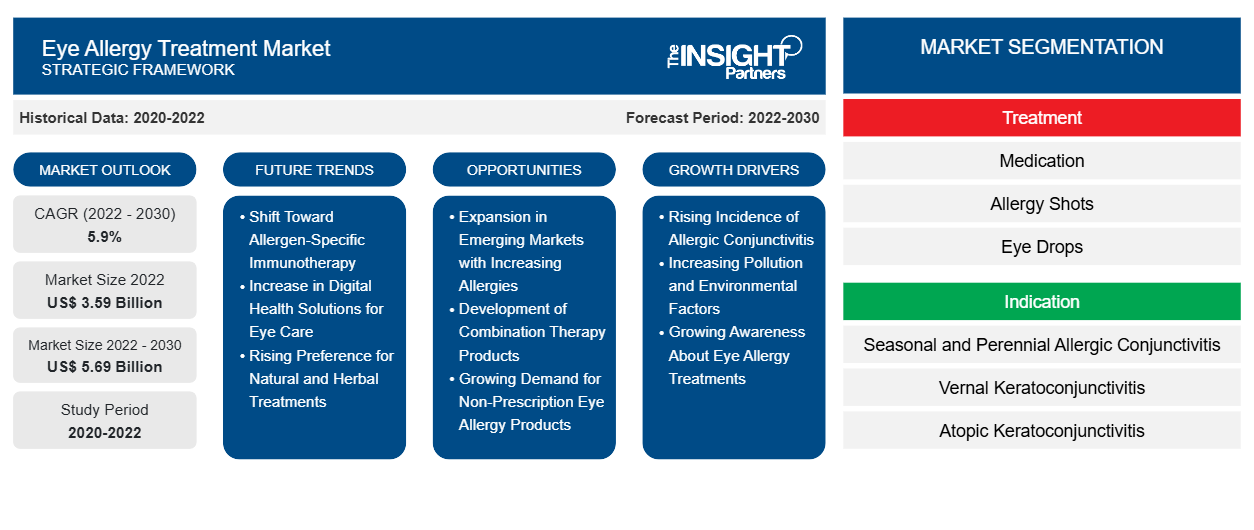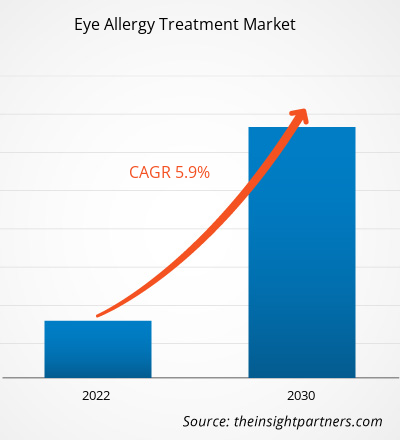[研究报告] 眼部过敏治疗市场规模预计将从 2022 年的 35.9 亿美元增至 2030 年的 56.9 亿美元;预计 2022-2030 年期间的复合年增长率为 5.9%。
市场洞察和分析师观点:
眼部过敏治疗包括非处方药和处方药,用于缓解眼睛发红、瘙痒、流泪和肿胀等症状。一些常用的产品包括抗组胺眼药水、肥大细胞稳定剂和联合疗法。眼部过敏的主要类型是季节性或常年性过敏性结膜炎、春季角结膜炎、特应性角结膜炎和接触性过敏性结膜炎。全球范围内眼部过敏的患病率不断上升,以及非处方解决方案的普及,有利于眼部过敏治疗市场的增长。
增长动力:
眼睛过敏,又称过敏性结膜炎,是由花粉、灰尘、动物和霉菌引起的。空气污染水平的上升导致眼睛过敏的发病率不断上升。此外,生活方式和饮食习惯的改变、接触过敏原的增加、看屏幕时间的增加导致眼睛疲劳以及眼睛不适的易感性增加,导致全球人口的眼睛过敏反应大幅增加。
根据 2020 年发表的一项名为“过敏性结膜炎的现代观点”的研究,过敏性眼病是北美人口的常见问题。它影响了近 40% 的人口,而且这个数字还在增长。美国一半患有眼部过敏症状的人口需要药物来缓解。尽管如此,只有一小部分人使用处方药,这使得这些新疗法的开发特别有吸引力。
眼部过敏治疗包括用于治疗和管理影响眼睛的过敏的产品和解决方案。治疗包括非处方药和处方药,用于缓解眼睛发红、瘙痒、流泪和肿胀等症状。一些常用的产品包括抗组胺眼药水、肥大细胞稳定剂和非甾体抗炎药。眼部过敏患者数量的增长导致对治疗方案的需求增加。这增加了对治疗选择的需求,从而推动了眼部过敏治疗市场的增长。
眼部过敏治疗市场的趋势包括联合疗法的开发,这将有利于未来市场的增长。
定制此报告以满足您的需求
您可以免费定制任何报告,包括本报告的部分内容、国家级分析、Excel 数据包,以及为初创企业和大学提供优惠和折扣
- 获取此报告的关键市场趋势。这个免费样品将包括数据分析,从市场趋势到估计和预测。
报告细分和范围:
眼部过敏治疗市场分析考虑了以下几个部分:治疗、适应症、分销渠道和地理区域。根据治疗,市场分为药物、过敏针和眼药水。根据适应症,市场分为季节性和常年性过敏性结膜炎、春季角结膜炎、特应性角结膜炎、接触性过敏性结膜炎和巨乳头状结膜炎。根据分销渠道,市场分为医院药房、网上药店和药店。
眼部过敏治疗市场报告的范围涵盖北美(美国、加拿大和墨西哥)、欧洲(法国、德国、英国、西班牙、意大利和欧洲其他地区)、亚太地区(中国、日本、印度、韩国、澳大利亚和亚太地区其他地区)、中东和非洲(沙特阿拉伯、阿联酋、南非和中东和非洲其他地区)以及南美洲和中美洲(巴西、阿根廷和南美洲和中美洲其他地区)。
节段分析:
眼部过敏治疗市场按治疗方法分为药物、过敏针剂和眼药水。眼药水部分在 2022 年占据了相当大的市场份额。预计在 2022-2030 年期间,该市场将创下最高复合年增长率。
根据适应症,市场分为季节性和常年性过敏性结膜炎、春季角结膜炎、特应性角结膜炎、接触性过敏性结膜炎和巨乳头状结膜炎。季节性和常年性过敏性结膜炎细分市场在 2022 年占据了眼部过敏治疗市场的很大份额,预计在 2022-2030 年期间将实现最高的复合年增长率。
根据分销渠道,市场分为医院药房、在线药房和药店。2022 年,医院药房占据了眼部过敏治疗市场的重要份额。此外,在线药房预计在 2022-2030 年期间的复合年增长率最高。
区域分析:
根据地理位置,眼部过敏治疗市场报告主要分为北美、欧洲、亚太地区、南美和中美以及中东和非洲。2022 年,北美占据了相当大的市场份额。2022 年,美国占据了该地区最大的市场份额。北美市场的增长归因于现代医疗基础设施的可用性、主要市场参与者的强大存在、眼部过敏和干眼症数量的增加以及尖端药物的引入。根据浸信会健康组织的数据,近 5000 万美国人患有某种形式的季节性过敏。大约 30% 的成年人和 40% 的儿童会出现影响眼睛、眼睑和泪管的过敏反应。
干眼症会导致眼部过敏,进而导致干眼症。干眼症在美国是一种常见但未被充分诊断的疾病。根据 2020 年发布的国家健康与保健调查数据,美国 6.8% 的成年人口被诊断患有干眼症。根据 2019 年发表的一篇文章《墨西哥干眼症患者眼表损伤的风险因素:一项基于人群的研究》,近 58% 的人抱怨眼睛干涩。
制药公司正在改善过敏缓解眼药水等专门治疗的可及性,以扩大其在该地区的业务范围。从 2022 年 3 月起,Allergan 的 LASTACAFT(0.25% 阿卡他定滴眼液)可供眼部过敏的美国人无需处方即可获得。在美国食品和药物管理局最近批准完全处方到非处方转换后,LASTACAFT 的原始专利处方强度配方可以在网上和销售非处方眼药水的零售店中找到。因此,上述因素推动了该地区眼部过敏治疗市场的发展。
眼睛过敏治疗市场区域洞察
Insight Partners 的分析师已详尽解释了预测期内影响眼部过敏治疗市场的区域趋势和因素。本节还讨论了北美、欧洲、亚太地区、中东和非洲以及南美和中美洲的眼部过敏治疗市场细分和地理位置。

- 获取眼部过敏治疗市场的区域特定数据
眼睛过敏治疗市场报告范围
| 报告属性 | 细节 |
|---|---|
| 2022 年市场规模 | 35.9亿美元 |
| 2030 年的市场规模 | 56.9 亿美元 |
| 全球复合年增长率(2022 - 2030 年) | 5.9% |
| 史料 | 2020-2022 |
| 预测期 | 2022-2030 |
| 涵盖的领域 | 按治疗
|
| 覆盖地区和国家 | 北美
|
| 市场领导者和主要公司简介 |
|
眼部过敏治疗市场参与者密度:了解其对业务动态的影响
眼部过敏治疗市场正在快速增长,这得益于终端用户需求的不断增长,这些需求源于消费者偏好的不断变化、技术进步以及对产品优势的认识不断提高等因素。随着需求的增加,企业正在扩大其产品范围,进行创新以满足消费者的需求,并利用新兴趋势,从而进一步推动市场增长。
市场参与者密度是指在特定市场或行业内运营的企业或公司的分布情况。它表明在给定市场空间中,相对于其规模或总市场价值,有多少竞争对手(市场参与者)存在。
在眼部过敏治疗市场运营的主要公司有:
- 博士伦
- 爱尔康
- 艾伯维
- 强生公司
- Akorn 公司
免责声明:上面列出的公司没有按照任何特定顺序排列。

- 了解眼部过敏治疗市场的主要参与者概况
行业发展和未来机遇:
- 2020 年 9 月,雷迪博士实验室在美国市场推出了一款非处方眼部过敏滴剂——盐酸奥洛他定滴眼液。该滴眼液用于暂时缓解因花粉、草、动物毛发和皮屑引起的眼睛发痒。
- 2020 年 2 月,爱尔康获得美国食品药品监督管理局 (FDA) 批准 Pataday 的每日一次缓解剂和 Pataday 的每日两次缓解剂在美国进行非处方销售。Pataday 品牌采用医生处方排名第一的眼部过敏止痒缓解成分,并包括首款无需处方即可购买的每日一次过敏止痒缓解滴剂。
竞争格局和重点公司:
眼部过敏治疗市场预测可以帮助利益相关者规划其增长战略。博士伦、爱尔康、艾伯维、强生、Akorn Inc.、Nicox、参天制药有限公司、梯瓦制药工业有限公司、诺华公司和太阳制药工业有限公司是该市场的主要参与者。这些公司专注于推出新的高科技产品、改进现有产品和扩大地域范围,以满足全球日益增长的消费者需求。
- 历史分析(2 年)、基准年、预测(7 年)及复合年增长率
- PEST 和 SWOT 分析
- 市场规模价值/数量 - 全球、区域、国家
- 行业和竞争格局
- Excel 数据集



Report Coverage
Revenue forecast, Company Analysis, Industry landscape, Growth factors, and Trends

Segment Covered
This text is related
to segments covered.

Regional Scope
North America, Europe, Asia Pacific, Middle East & Africa, South & Central America

Country Scope
This text is related
to country scope.
常见问题
The global eye allergy treatment market is segmented based on treatment, indication, and distribution channel. The eye allergy treatment market, by treatment, is categorized into medication, allergy shots, and eye drops. The eye drops segment held a significant market share in 2022 and is anticipated to record the highest CAGR in the market during 2022–2030.
The eye allergy treatment market was valued at US$ 3.59 billion in 2022.
The eye allergy treatment market is expected to be valued at US$ 5.69 billion in 2030.
Eye allergy treatment includes products and solutions that are used to treat and manage allergies affecting the eyes. Treatment includes over-the-counter medications and prescription drugs that are used to alleviate symptoms such as redness, itching, tearing, and swelling of the eyes. Some of the commonly used products include antihistamine eye drops, mast cell stabilizers, and combination therapies.
The factors driving the growth of the eye allergy treatment market include the increasing prevalence of eye allergies worldwide and a significant number of switches from prescription to over-the-counter drugs. However, a lack of awareness of ocular allergies hampers the growth of the eye allergy treatment market.
The eye allergy treatment market majorly consists of the players, including Bausch + Lomb, Alcon, AbbVie, Johnson & Johnson, Akorn Inc., Nicox, Santen Pharmaceutical Co. Ltd, Teva Pharmaceutical Industries Ltd, Novartis AG, and Sun Pharmaceutical Industries Ltd.
Trends and growth analysis reports related to Life Sciences : READ MORE..
The List of Companies - Eye Allergy Treatment Market
- Bausch + Lomb
- Alcon
- AbbVie
- Johnson & Johnson
- Akorn Inc.
- Nicox
- Santen Pharmaceutical Co. Ltd
- Teva Pharmaceutical Industries Ltd
- Novartis AG
- Sun Pharmaceutical Industries Ltd.
The Insight Partners performs research in 4 major stages: Data Collection & Secondary Research, Primary Research, Data Analysis and Data Triangulation & Final Review.
- Data Collection and Secondary Research:
As a market research and consulting firm operating from a decade, we have published and advised several client across the globe. First step for any study will start with an assessment of currently available data and insights from existing reports. Further, historical and current market information is collected from Investor Presentations, Annual Reports, SEC Filings, etc., and other information related to company’s performance and market positioning are gathered from Paid Databases (Factiva, Hoovers, and Reuters) and various other publications available in public domain.
Several associations trade associates, technical forums, institutes, societies and organization are accessed to gain technical as well as market related insights through their publications such as research papers, blogs and press releases related to the studies are referred to get cues about the market. Further, white papers, journals, magazines, and other news articles published in last 3 years are scrutinized and analyzed to understand the current market trends.
- Primary Research:
The primarily interview analysis comprise of data obtained from industry participants interview and answers to survey questions gathered by in-house primary team.
For primary research, interviews are conducted with industry experts/CEOs/Marketing Managers/VPs/Subject Matter Experts from both demand and supply side to get a 360-degree view of the market. The primary team conducts several interviews based on the complexity of the markets to understand the various market trends and dynamics which makes research more credible and precise.
A typical research interview fulfils the following functions:
- Provides first-hand information on the market size, market trends, growth trends, competitive landscape, and outlook
- Validates and strengthens in-house secondary research findings
- Develops the analysis team’s expertise and market understanding
Primary research involves email interactions and telephone interviews for each market, category, segment, and sub-segment across geographies. The participants who typically take part in such a process include, but are not limited to:
- Industry participants: VPs, business development managers, market intelligence managers and national sales managers
- Outside experts: Valuation experts, research analysts and key opinion leaders specializing in the electronics and semiconductor industry.
Below is the breakup of our primary respondents by company, designation, and region:

Once we receive the confirmation from primary research sources or primary respondents, we finalize the base year market estimation and forecast the data as per the macroeconomic and microeconomic factors assessed during data collection.
- Data Analysis:
Once data is validated through both secondary as well as primary respondents, we finalize the market estimations by hypothesis formulation and factor analysis at regional and country level.
- Macro-Economic Factor Analysis:
We analyse macroeconomic indicators such the gross domestic product (GDP), increase in the demand for goods and services across industries, technological advancement, regional economic growth, governmental policies, the influence of COVID-19, PEST analysis, and other aspects. This analysis aids in setting benchmarks for various nations/regions and approximating market splits. Additionally, the general trend of the aforementioned components aid in determining the market's development possibilities.
- Country Level Data:
Various factors that are especially aligned to the country are taken into account to determine the market size for a certain area and country, including the presence of vendors, such as headquarters and offices, the country's GDP, demand patterns, and industry growth. To comprehend the market dynamics for the nation, a number of growth variables, inhibitors, application areas, and current market trends are researched. The aforementioned elements aid in determining the country's overall market's growth potential.
- Company Profile:
The “Table of Contents” is formulated by listing and analyzing more than 25 - 30 companies operating in the market ecosystem across geographies. However, we profile only 10 companies as a standard practice in our syndicate reports. These 10 companies comprise leading, emerging, and regional players. Nonetheless, our analysis is not restricted to the 10 listed companies, we also analyze other companies present in the market to develop a holistic view and understand the prevailing trends. The “Company Profiles” section in the report covers key facts, business description, products & services, financial information, SWOT analysis, and key developments. The financial information presented is extracted from the annual reports and official documents of the publicly listed companies. Upon collecting the information for the sections of respective companies, we verify them via various primary sources and then compile the data in respective company profiles. The company level information helps us in deriving the base number as well as in forecasting the market size.
- Developing Base Number:
Aggregation of sales statistics (2020-2022) and macro-economic factor, and other secondary and primary research insights are utilized to arrive at base number and related market shares for 2022. The data gaps are identified in this step and relevant market data is analyzed, collected from paid primary interviews or databases. On finalizing the base year market size, forecasts are developed on the basis of macro-economic, industry and market growth factors and company level analysis.
- Data Triangulation and Final Review:
The market findings and base year market size calculations are validated from supply as well as demand side. Demand side validations are based on macro-economic factor analysis and benchmarks for respective regions and countries. In case of supply side validations, revenues of major companies are estimated (in case not available) based on industry benchmark, approximate number of employees, product portfolio, and primary interviews revenues are gathered. Further revenue from target product/service segment is assessed to avoid overshooting of market statistics. In case of heavy deviations between supply and demand side values, all thes steps are repeated to achieve synchronization.
We follow an iterative model, wherein we share our research findings with Subject Matter Experts (SME’s) and Key Opinion Leaders (KOLs) until consensus view of the market is not formulated – this model negates any drastic deviation in the opinions of experts. Only validated and universally acceptable research findings are quoted in our reports.
We have important check points that we use to validate our research findings – which we call – data triangulation, where we validate the information, we generate from secondary sources with primary interviews and then we re-validate with our internal data bases and Subject matter experts. This comprehensive model enables us to deliver high quality, reliable data in shortest possible time.


 获取此报告的免费样本
获取此报告的免费样本